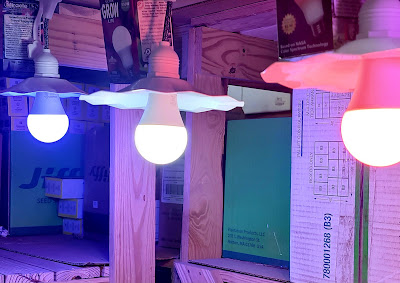Growing herbs indoors in the winter is a great way to add a touch of greenery to your home and have fresh and flavorful ingredients for your culinary dishes. It's hard to beat homegrown herbs and if you've got a sunny window, you can enjoy the convenience of fresh herbs through the winter months. Growing herbs indoors makes it easy to snip fresh foliage to flavor meals whenever you need them.
Some of the herbs that do well indoors include basil, chives, mint, parsley, oregano, thyme, rosemary, dwarf sage, and dill. Many herbs can be grown from seed, but for quicker results, choose healthy starter plants.
The key factor for growing herbs indoors is light. You can grow a wide variety of herbs indoors anywhere they will get at least six hours of sunlight, such as a south or west facing window. Your other option is to supplement your natural lighting with artificial lighting.
Grow bulbs are available which will fit a standard socket such as a desk lamp. This makes it easier to achieve the light you need to grow the herbs indoors successfully. An alternative would be T5 fluorescent lighting. Plan to keep lights on 8 to 10 hours a day, with bulbs hung 6-8 inches above the tops of the plants. If your plants start getting tall and spindly, they’re not getting enough light.
Providing the right amount of light and the correct ambient temperature encourages strong, healthy growth of your herb plants and the best tasting foliage.
Most herbs prefer temperatures of 65 to 75 degrees F. It’s important to keep your plants away from drafts. Plants can be close to windows but not touching the pane. If the window is too cold, move the plants a little further away from it.
Other factors to consider when growing your own herbs indoors include space, growing media, containers, and fertilizer.
The more space you have, the more or larger plants you can grow. If you have limited space, choose the one or two herbs you will use most often.
If you’re repotting your herbs, use a high-quality potting soil formulated for indoor plants. It should hold enough water for optimum plant growth but should also drain well as herbs do not like wet feet.
You can use any container you like. This includes clay, ceramic, or plastic. The container must have drain holes. It is not necessary to add rocks or pot shards to the bottom of the pot. Because water is going to come out of the pot, you’ll need a saucer to catch the overflow.
How frequently you'll need to water will depend on several factors, including ambient temperature, amount of light available, humidity level, and how actively plants are growing. Make sure you're watering only when the plants need it, not on a fixed schedule. To decide if it's time to water you can use the finger method, poking into the soil up to your second knuckle to see if the soil is still moist. You can also use the weight test by lifting the pot. As you do this before and after watering, you'll learn how light the pot should feel when it is ready for watering.
A few solutions for increasing moisture in the air around your plants include setting pots of herbs on a tray filled with river rocks or gravel, then adding water to the tray. Just make sure the bottom of the pot is not touching the water. Grouping plants together, so they create their own little micro-climate in the room.
In winter your plants won't be growing as actively as at other times of the year and will need less frequent feeding. When you do fertilize, choose a fertilizer with an OMRI seal. It’s your guarantee that the fertilizer is organic.
By growing your own culinary herbs indoors, you will be rewarded with fresh cooking herbs you grow and harvest yourself, as well as the color and aroma herbs bring to the room.










No comments:
Post a Comment